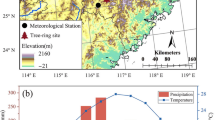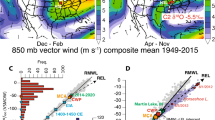Abstract
Event-based sampling of isotopes in precipitation (δ18O and δ2H) was done in a large European Moscow city (Russian Federation) to understand modern climate variability and isotopic sensitivity to air temperature and precipitation amount. A strong seasonality of δ18O and δ2H values, with a maximum in summer and a minimum in winter, was a consequence of the temperature effect as expressed by significant correlation (r = 0.76). Compared with historical monthly values (Global Network of Isotopes in Precipitation in 1970–1979), event-based stable isotope values in monthly means were lower in March and October and slightly higher in summer due to larger variability in precipitation amount of some events and, particularly, by an increase of the precipitation amount amplitude in last years, relative to the long-term. The isotopic signature of some monthly precipitation values was determined by the predominant role of one or two events, which provide up to 50% of the monthly value. A wide range of d-excess values from − 8.7 to + 27.9‰ for individual events was associated with a frequent change in air masses trajectories moving through Moscow, high mobility of atmospheric transport and cyclonic activity. The low correlation of δ18O values with the North Atlantic Oscillation (NAO) index, absence of the significant relationship between NAO, air temperature and precipitation amount were indicative for a partial effect of the NAO on the precipitation patterns and isotopic composition of precipitation in Moscow. The study provides a first background for understanding of hydrometeorological processes using event based isotopic signature in East European precipitation.








Similar content being viewed by others
Data availability
Published data will be available at https://nucleus.iaea.org/wiser.
Code availability
Not applicable.
References
Aemisegger F (2018) On the link between the North Atlantic storm track and precipitation deuterium excess in Reykjavik. Atmos Sci Lett 19(12):e865. https://doi.org/10.1002/asl.865
Aggarwal PK, Romatschke U, Araguás-Araguás L et al (2016) Proportions of convective and stratiform precipitation revealed in water isotope ratios. Nat Geosci 9(8):624–629. https://doi.org/10.1038/ngeo2739
Baldini LM, McDermott F, Foley AM, Baldini JUL (2008) Spatial variability in the European winter precipitation δ18O-NAO relationship: Implications for reconstructing NAO-mode climate variability in the Holocene. Geophys Res Lett 35:L04709. https://doi.org/10.1029/2007GL032027
Bailey HL, Klein ES, Welker JM (2019) Synoptic and mesoscale mechanisms drive winter precipitation δ18O/δ2H in south-central Alaska. J Geophys Res Atmos 124:4252–4266. https://doi.org/10.1029/2018JD030050
Brown J, Simmonds I, Noone D (2006) Modelling data δ18O in tropical precipitation and the surface ocean for present-day climate. J Geophys Res Atmos 111:D05105
Comas-Bru L, McDermott F, Werner M (2016) The effect of the East Atlantic pattern on the precipitation δ18O-NAO relationship in Europe. J Clim Dyn 47:2059–2069. https://doi.org/10.1007/s00382-015-2950-1
Chizhova JN, Eremina ID, Budantseva NA, Surkova GV, Vasil’chuk YuK (2017) Concentration of 18O in precipitation over Moscow in 2014. Russ Meteorol Hydrol 42(1):54–63
Dansgaard W (1964) Stable isotopes in precipitation. Tellus 16:436–468. https://doi.org/10.1111/j.2153-3490.1964.tb00181.x
Diadin D, Vystavna Y (2020) Long-term meteorological data and isotopic composition in precipitation, surface water and groundwater revealed hydrologic sensitivity to climate change in East Ukraine. Isot Environ Health Stud 56(2):136–148. https://doi.org/10.1080/10256016.2020.1732369
Duliński M, Ryżański K, Pierchała A, Gorczyca Z, Marzec M (2019) Isotopic composition of precipitation in Poland: a 44-year record. Acta Geophys 67:1637–1648
Draxler RR, Rolph GD (2011) HYSPLIT (HYbrid single-particle Lagrangian integrated trajectory). NOAA Air Resources Laboratory, Silver Spring
Fricke HC, O’Neil JR (1999) The correlation between 18O/16O ratios of meteoric water and surface temperature: its use in investigating terrestrial climate change over geologic time. Earth Planet Sci Lett 170(3):181–196. https://doi.org/10.1016/s0012-821x(99)00105-3
Friedman I, Harris JM, Smith GI, Johnson CA (2002) Stable isotope composition of waters in the Great Basin, United States 1. Air-Mass Trajectories J Geophys Res Atmos 107(D19):4400. https://doi.org/10.1029/2001jd000565
Fröhlich K, Kralik W, Papesch W, Rank D, Scheifinger H, Stichler W (2008) Deuterium excess in precipitation of Alpine regions—moisture recycling. Isot Environ Health S 44(1):61–70. 61–70.https://doi.org/10.1080/10256010801887208
Fröhlich K, Gibson JJ, Aggarwal PK (2002) Deuterium excess in precipitation and its climatological significance. Proceedings of the study of environmental change using isotope techniques. International Atomic Energy Agency, Vienna. 54–66pp.
Gao J, Risi C, Masson-Delmotte V, He Y, Xu B (2016) Southern Tibetan Plateau ice core δ18O reflects abrupt shifts in atmospheric circulation in the late 1970s. Clim Dyn 46:291–302
Gat JR, Carmi I (1970) Evolution of the isotopic composition of atmospheric waters in the Mediterranean Sea area. J Geophys Res 75:3039–3048
Gat JR, Mook WG, Rozanski K, Fröhlich K (2001) Environmental isotopes in the hydrological cycle: Principles and applications, vol 2. UNESCO, Paris
Guo H, Zhu G, He Y et al (2019) Dynamic characteristics and influencing factors of precipitation δ18O, China. Theor Appl Climatol 138:899–910. https://doi.org/10.1007/s00704-019-02867-z
Hager B, Foelsche U (2015) Stable isotope composition of precipitation in Austria. Austrian Journal of Earth Sciences 108. https://doi.org/10.17738/ajes.2015.0012
Heydarizad M, Raeisi E, Sori R et al (2019) An overview of the atmospheric moisture transport effect on stable isotopes (δ18O, δ2H) and D excess contents of precipitation in Iran. Theor Appl Climatol 138:47–63. https://doi.org/10.1007/s00704-019-02798-9
Hurrell JW, Kushnir Y, Ottersen G, Visbeck M (2003) The North Atlantic Oscillation: Climate Significance and Environmental Impact. Geophysical Monograph Series 134, 279 p.
Jouzel J, Merlivat L, Lorius C (1982) Deuterium excess in an East Antarctic ice core suggests higher relative humidity at the oceanic surface during the last glacial maximum. Nature 299(5885):688–691. https://doi.org/10.1016/j.quascirev.2006.07.015
Jouzel J, Merlivat L (1984) Deuterium and O-18 in precipitation—modeling of the isotopic effects during snow formation. J Geophys Res 89:11749–11757
Juhlke TR, Meier C, van Geldern R, Vanselow KA, Wernicke J, Baidulloeva J, Barth JAC, Weise SM (2019) Assessing moisture sources of precipitation in the Western Pamir Mountains (Tajikistan, Central Asia) using deuterium excess, Tellus B: Chemical and Physical Meteorology, 71:1, 1601987 https://doi.org/10.1080/16000889.2019.1601987
Kadygrov EN, Kuznetsova IN, Golitsyn GS (2002) Urban heat island: new results on the base of remote sensing data. Doklady Earth Science 385(4):541–548
Klein ES, Cherry JE, Young J, Noone D, Leffler AJ, Welker JM (2015) Arctic cyclone water vapor isotopes support past sea ice retreat recorded in Greenland ice. Sci Rep 5(10295):10295
Krklec K, Domínguez-Villar D, Lojen S (2018) The impact of moisture sources on the oxygen isotope composition of precipitation at a continental site in central Europe. J Hydrol 561:810–821. https://doi.org/10.1016/j.jhydrol.2018.04.045
Kurita N (2011) Origin of Arctic water vapor during the ice-growth season. Geophys Res Lett 38(2):L02709. https://doi.org/10.1029/2010GL046064
Merlivat L, Jouzel J (1979) Global climatic interpretation of the deuterium-oxygen 18 relationship for precipitation. J Geophys Res Oceans 84:5029–5033. https://doi.org/10.1029/JC084iC08p05029
Pfahl S, Sodemann H (2014) What controls deuterium excess in global precipitation? Climate of the past 10:771–781. https://doi.org/10.5194/cp-10-771-2014
Rolph G, Stein A, Stunder B (2017) Real-time environmental applications and display system: READY. Environ Model Software 95:210–228. https://doi.org/10.1016/j.envsoft.2017.06.025
Rozanski K, Sonntag C, Munnich KO (1982) Factors controlling stable isotope composition of European precipitation. Tellus 34:142–150. https://doi.org/10.1111/j.2153-3490.1982.tb01801.x
Rozanski K, Araguás-Araguás L, Gonfiantini R (1992) Relation between long-term trends of oxygen-18 isotope composition of precipitation and climate. Science 258:981–985. https://doi.org/10.1126/science.258.5084.981
Salamalikis V, Argiriou A, Dotsika E (2016) Periodicity analysis of δ18O in precipitation over Central Europe: Time–frequency considerations of the isotopic ‘temperature’ effect. J Hydrol 534:150–163
Sjostrom DJ, Welker JM (2009) The influence of air mass source on the seasonal isotopic composition of precipitation, eastern USA. J Geochem Explor 102(3):103–112. https://doi.org/10.1016/j.gexplo.2009.03.001
Sodemann H, Schwierz C, Wernli H (2008) Interannual variability of Greenland winter precipitation sources: Lagrangian moisture diagnostic and North Atlantic Oscillation influence. J Geophys Res 113(D3):D03107. https://doi.org/10.1029/2007JD008503
Stein AF, Draxler RR, Rolph GD, Stunder BJB, Cohen MD, Ngan F (2015) NOAA’s HYSPLIT atmospheric transport and dispersion modeling system. Bull Am Meteorol Soc 96:2059–2077. https://doi.org/10.1175/BAMS-D-14-00110.1
Terzer-Wassmuth S, Wassenaar LI, Welker J, Araguas-Araguas LJ (2021) New high-resolution global and regionalized isoscapes of δ18O, δ2H, and d-excess in precipitation. Hydrol. Process 35(6):e14254
Vachon RW, Welker JM, White JWC, Vaughn BH (2010) Monthly precipitation isoscapes (δ18O) of the United States: connections with surface temperatures, moisture source conditions, and air mass trajectories. J Geophys Res 115:D21126. https://doi.org/10.1029/2010JD014105
van der Ent R, Tuinenburg OA (2017) The residence time of water in the atmosphere revisited. Hydrol Earth Syst Sci 21:779–790. https://doi.org/10.5194/hess-21-779-2017
Vystavna Y, Hejzlar J, Kopáček J (2017) Long-term trends of phosphorus concentrations in an artificial lake: Socio-economic and climate drivers. PLoS One 12(10):e0186917. https://doi.org/10.1371/journal.pone.0186917
Vystavna Y, Matiatos I, Wassenaar LI (2020) 60-year trends of δ18O in global precipitation reveal large scale hydroclimatic variations. Glob Planet Change. 103335https://doi.org/10.1016/j.gloplacha.2020.103335
Vystavna Y, Matiatos I, Wassenaar LI (2021) Temperature and precipitation effects on the isotopic composition of global precipitation reveal long-term climate dynamics. Sci Rep 11:18503. https://doi.org/10.1038/s41598-021-98094-6
Uemura R, Matsui Y, Yoshimura K, Motoyama H, Yoshida N (2008) Evidence of deuterium excess om water vapor as an indicator of ocean surface condition. J Geophys Res 113:D19114. https://doi.org/10.1029/2008JD010209
Wang Y, Tang Y, Xu Y et al (2021) Isotopic dynamics of precipitation and its regional and local drivers in a plateau inland lake basin, Southwest China. Sci Total Environ 763:143043. https://doi.org/10.1016/j.scitotenv.43043
Acknowledgements
This work was supported by IAEA [Research Contract № 23109] and Interdisciplinary Scientific and Educational School of M.V. Lomonosov Moscow State University «Future Planet and Global Environmental Change».
Funding
This work was supported by IAEA [Research Contract № 23109]; Russian Scientific Foundation [grant № 19–77-30004]; Russian Foundation of Basic Research [grant № 20–05-00782].
Author information
Authors and Affiliations
Corresponding author
Ethics declarations
Ethics approval
Not applicable.
Consent to participate
Not applicable.
Consent for publication
Not applicable.
Conflict of interest
The authors declared no conflict of interest.
Additional information
Publisher's note
Springer Nature remains neutral with regard to jurisdictional claims in published maps and institutional affiliations.
Supplementary Information
Below is the link to the electronic supplementary material.
Rights and permissions
About this article
Cite this article
Vasil’chuk, Y., Chizhova, J., Budantseva, N. et al. Stable isotope composition of precipitation events revealed modern climate variability. Theor Appl Climatol 147, 1649–1661 (2022). https://doi.org/10.1007/s00704-021-03900-w
Received:
Accepted:
Published:
Issue Date:
DOI: https://doi.org/10.1007/s00704-021-03900-w




